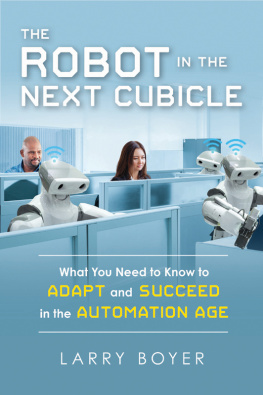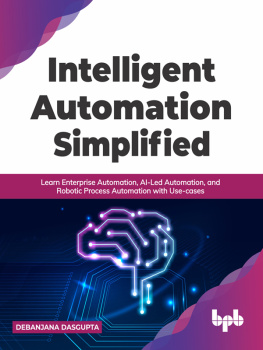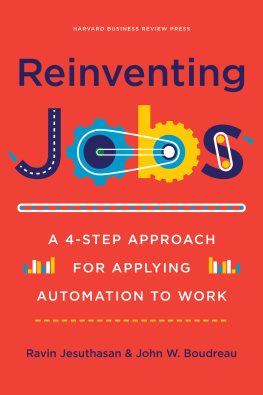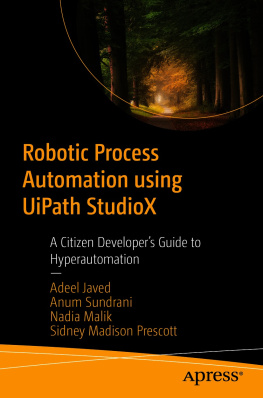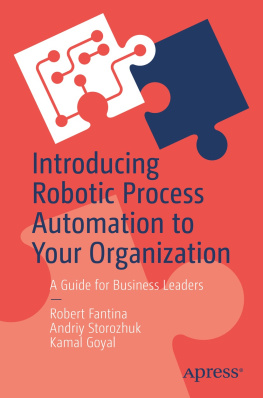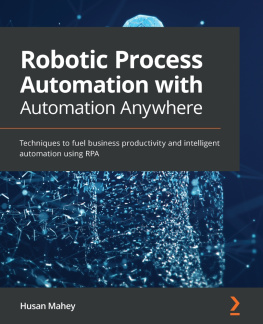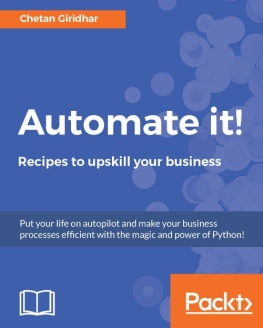A GUIDE TO ROBOTIC PROCESS AUTOMATION FOR THE AVERAGE WORKER
RPA Use Cases, and How to Keep Your Job Safe from Bots
Zachary Williams
Copyright 2019, (Zachary Williams) All rights reserved. The contents of this book may not be reproduced, duplicated or transmitted without direct written permission from the author. Under no circumstances will any legal responsibility or blame be held against the publisher for any reparation, damages, or monetary loss due to the information herein, either directly or indirectly. Legal Notice: This book is copyright protected. This is only for personal use. You cannot amend, distribute, sell, use, quote or paraphrase any part of the content within this book without the consent of the author
TABLE OF CONTENTS
Chapter Summary......................................................5
Chapter Summary.................................................... 21
i
Advantages .............................................................. 26
Chapter Summary ................................................... 34
ii
Chapter Summary:...................................................57
iii
iv
v
Introduction
The business landscape is always in a dilemma. Innovations and strategies are being released at what looks like the speed of light. A recent technology that has been raising a lot of dusk on the internet is Robotic Process Automation, as well as Artificial Intelligence. It was often believed in some tech circles that it would attain its peak in the year 2020.
To fully understand this technology, I have quickly provided an overview of this technology in this introductory chapter to go in-depth as you progress in reading this book.
So what is RPA?
RPA can be defined as the deployment of machines to implement job functions with higher accuracy and precision at rapid frequencies. In other words, it is a procedure whereby business processes are automated, leveraging on robots to minimize human intervention.
Do we have different types of RPA?
RPA has many use cases in diverse sectors, as we will consider in the subsequent chapters. Different types of RPA also exist for businesses in the market today. Big companies have been cutting down on cost by leveraging the technology, while an average worker has become more efficient. Virtual robots, for instance, can be deployed to implement processes such as reading a claim form, sorting it, and inputting the data into a different system. These forms of robots are called "working robots."
Some virtual robots are also deployed for tracking and to achieve quality assurance. These forms of bots are not designed to implement jobs or complete transactions. Their primary functions are to monitor, as well as flag issues that do not comply with quality assurance in the business process. For instance, if an enterprise has an online marketplace, the roles of the bots are to check for lags or breakdowns throughout the shopping experience. This helps the IT department to undertake a proactive approach instead of a reactive one.
So how did RPA evolve?
Automation has been with us for some decades now. It has been evolving over the years. It began from the automation of screen scraping to workflow automation. It finally gained scripting and recording capabilities. We considered the future of technology in the last chapter as a situation where RPA leverages Machine Learning and Artificial Intelligence.
RPA Adoption
Before this time, the technology was available to large scale enterprises that needed to solve the issue of repetitive functions, as well as reduction of overhead costs. The large scale enterprises brought in developers and programmers to implement virtual robots across their business processes. Presently, the technology
prominence
has gained significant in critical sectors and
industries. We highlighted the use cases in the subsequent chapters across sectors and industries. It has been estimated that the market will exceed $1billion in the coming years.
The RPA technology has gone past the adoption stage, and many believed it would peak from 2020.
Sourcing RPA
Several vendors are upping their game right now in the RPA market to provide customized solutions for clients.
Do you think this technology will replace you as an average worker in the coming year? Do you believe RPA will be a turn-key option for you as a business owner? What are the benefits of this technology? Are Robots the same as RPA? What can RPA do? What skills are essentials to remain relevant as an average worker, and how do you stay relevant in a fast-changing technological landscape?
I provide answers to these questions on every page of this book.
Chapter 2: Why RPA?
Chapter Summary
As of 2017, the RPA global market volume stood at 1.3 million USD; it is forecasted to attain $5billion by 2020. This is equal to a yearly growth of 56%. The fundamental question as this market begins to expand is, 'Why RPA?'
RPA technology is presently being utilized in the health and financial industries. About 69% of large scale enterprises are recorded to be the major actors. 54% of all enterprises have already implemented RPA in North America, while about 34% have adopted it in Western Europe. Many vendors are striving to embed artificial intelligence into the solutions they offer, while some have already incorporated it. AI is expected to lead the future of RPA as it will take to assume a significant function in this aspect. Moreover, cognitive skills and competencies enhance smarter and efficient solutions.
RPA Predictions
RPA is predicted to possibly automate all voluminous and repetitive activities that are rule-based at both back-end and frontend. It will routinely extract data from diverse sources or store them in the required database. It will utilize cognitive abilities by 2023 to pick the next point of action from a specific list of choices.
In ten years from now, RPA applications will fully employ Artificial Intelligence to aid learning and upgrade themselves. All backoffice activities will be processed from start to finish without human input.
As long as we have experts that are ready and able to design, develop, as well as, implement RPA solutions on a large scale, this technological prediction will be easily achieved.
Impact of RPA on Back-office Activities
When a normal office considers implementing RPA, the first question it needs to ask is, 'Which of the activities deserves automation instead of which professional roles ought to be automated.
The goal of automation is to significantly optimize the efficiency of an average worker and assist team members in concentrating the job aspects that are more challenging and interesting. In a nutshell, automate boring tasks and allow humans to perform interesting tasks.
In reality, we will see a dramatic disruption in several units of an organization. For instance, RPA will minimize employee requirements by 28% to 48% in the coming years. RPA will free some team members for roles that produce additional value. In the real sense, not all processes deserve automation. For instance, RPA major focus should be on tracking receivables due and the collection of the same in the accounting department. It should also be deployed to manage data entry as well as review in order processing.


